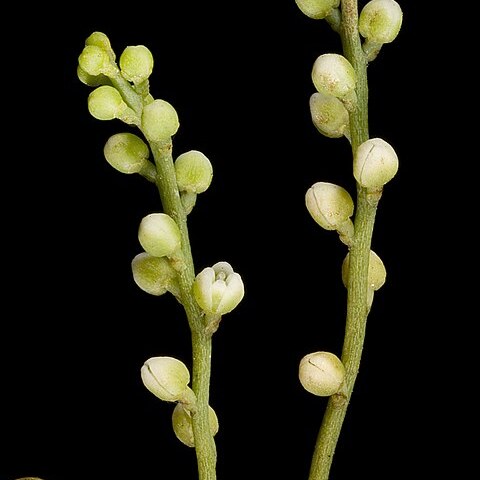Stem (0.3–) 0.7–2 mm thick, glabrescent to pubescent, light yellow-green or brownish to dark green. Leaves ovate-peltate, 1.5–2.5 × 0.5–0.8 mm. Inflorescence a loose raceme or head (1–) 4–8 (–10)-flowered, single, paired or fasciculate, sometimes paniculate; peduncles 3–30 × 0.5–1 mm, glabrescent to pubescent. Pedicel 1–2 × 0.3–0.8 mm, pubescent or glabrescent. Floral bracts inserted at 2 levels; bract ovate and peltate, 0.5–1.2 × 0.3–0.5 mm, pubescent to glabrescent, ciliate; bracteoles smaller, persistent in fruit. Flowers ovoid, 1–2 × 0.9–1.5 mm, white to greenish yellow, pubescent. Sepals triangular-ovate to round, 0.5–0.7 mm, pubescent to glabrescent, ciliate. Petals ovate, 1–1.8 × 0.8–1.5 mm, pubescent to glabrescent outside, appressed white-hairy inside. Fertile stamens 6, first and third whorl light-yellow or white; stamens of second whorl (opposite petals) reduced to staminodes, filiform and c. 1 × 0.3 mm, often adhering to petals throughout length. Staminodes conical, c. 0.5 × c. 0.35 mm, commonly white, occasionally white-tipped; glands ovoid, c. 0.5 mm, occasionally white-tipped. Ovary fusiform, 1–1.5 × c. 0.5 mm, pubescent all over or only in a transverse median ring.
More
A twining plant. The stems are greenish-brown to yellow-orange. Plants have small suckers along the stem which attach to trees. The leaves are very small and scale like. The flowers are white, green and yellow. The fruit have a succulent outer part. There is one seed inside. The fruit are 6-7 mm long. The fruit are edible.

